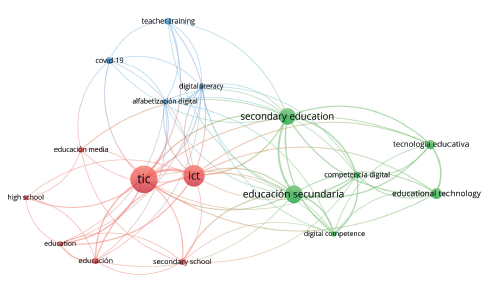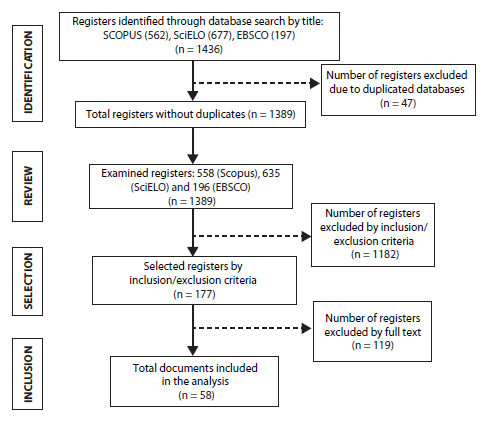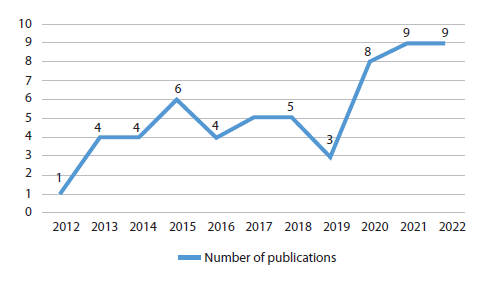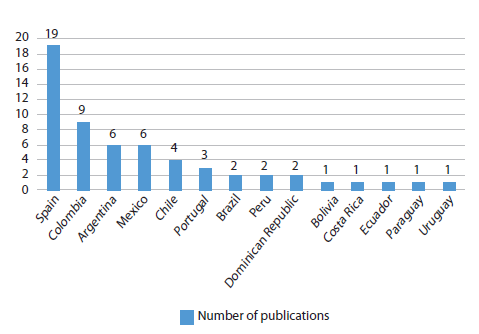Introduction
Since the late 20th century, society has been experiencing an unprecedented technological revolution resulting from the industrial development of the last decades, shaping the world as it is. As in the previous industrial revolutions, current times show a series of changes characterized by new technologies which started to increase their presence and impact on different daily-life aspects (Calderón, 2019). Throughout the years, tools such as Internet have become widely used worldwide, particularly among youngest generations. It is in this context where the so-called information and communications technology (ICT) appears as a set of digital tools which have gained increasing relevance thanks to their great potential for interconnecting people (Álvarez et al., 2019).
Nowadays it is increasingly common for people to be in contact with new technologies from an early age, and therefore they develop a series of skills and abilities specific to the technological sphere. Those digital skills are gaining momentum within the educational area, as they become key tools to face current and future challenges of a society ruled by technological change (Barbudo et al., 2021). For this reason, in the last three decades new initiatives to take traditional education a step forward towards digital education have been promoted to run with the times. As technologies such as internet and social media are a crucial part of nowadays society, it is the duty of the educational system to reinvent itself and acquire those new tools (Zanotti & Grasso, 2020).
The educational use of Internet-enabled computers and mobile devices has the advantage of facilitating access to education and improving its quality (Torras, 2021). Thanks to the ICTs, people can easily communicate around the world and exchange information, what in the educational sphere allows to update the teaching-learning process. It is also possible to create a much more interactive educational experience, based in the use of audiovisual material, and better adapted to the personal needs of each student (Gallo et al., 2021). Likewise, the use of ICTs in the methodological context allows teachers to innovate and foster students' both personal initiative and self-learning, which is also known as discovery learning (Alvarez et al., 2019).
However, the presence of ITCs in education entails, in turn, the development of new digital skills and competencies on the part of teachers, so they can adapt themselves to this new reality (Lorenzo et al., 2019). On the so-called digital immigrants -in this case, teachers- falls the task of successfully incorporating technology in the educational environment and leverage it to catch the interest of the digital natives or younger generations (González et al., 2020). Nevertheless, there are other challenges to face before institutions may use ICTs properly taking advantage of all their potential. For example, not all have the required digital infrastructure needed to their implementation, or the right pedagogical model for the new virtual environments to be created (Guiot, 2021).
In this context, it was considered relevant to conduct a systematic review of academic sources addressing the use of ICTs as valuable resources for the teaching approach and the strategies used by students inside and outside the classroom to acquire new skills and competencies. Therefore, this study aims to analyze information on the relevance of ICTs in secondary education learning, in order to determine their degree of influence and the most popular tools used in this area.
Methodology
For this study, a systematic review was conducted to analyze the scientific literature published in the last decade on the use of ITCs as tools generating a change in the methodological process of secondary education learning. This review has the objective to explore the influence of ICTs on students' learning, as well as the most effective tools to this aim. For this purpose, the PRISMA (Preferred Reporting Items for Systematic reviews and Meta-Analyses) guidelines were followed, as they confer a comprehensive manual to appropriately and systematically review all the articles collected according to their central subject (Sánchez et al., 2022). Starting from this, the following research questions arose.
Q1: What has been the role of ICTs in secondary education in the last years?
Q2: What has been the impact of the COVID-19 pandemic on the implementation of ITCs in secondary education?
With the aim of answering these questions and exploring in-depth the evolution of the ICTs in the educational sphere -including the pandemic period-, the time span was limited to a decade in the search, specifically the years 2012 until 2022, and articles from all over the world were included. Thus, it was possible to gather more information about the changes experienced in secondary education regarding the gradual implementation of new digital tools. Likewise, it was attainable to explore ICTs in different stages of their development and massification within the educational system, and the level of priority they have gained in different contexts.
In order to compile the publications, three widely used bibliographic databases were considered: Scientific Electronic Library Online (SciELO), ScienceDirect (Scopus), and EBSCO. Among others, the following Spanish keywords were introduced in the search sections: "tecnologías de información y comunicación", "educación secundaria", "educación digital", or "virtualidad". The combination of these keywords and the use of Boolean operators such as AND and OR allowed to complete the initial search of a group of articles related with the subject, using commands such as, for example, "[(Tecnologías de la información y comunicación), (ICT), (educación), and (secundaria)]".
Once the initial selection of publication was obtained, inclusion and exclusion criteria illustrated in Table 1 were considered to conduct the final selection of articles to be included in the systematic review.
Table 1 Inclusion and exclusion criteria.
| Inclusion criteria | Exclusion criteria |
|---|---|
| Articles focused on the use of ICTs in secondary school | Studies focused on other educational levels or not related to education |
| Articles published between 2012 and 2022 | Articles published in other years different from the range defined |
| Articles published in English, Portuguese, or Spanish with full text available | Articles published in other languages |
| Articles published in SciELO, Scopus, or EBSCO | Articles from unreliable sources |
| Articles of qualitative or quantitative research | Book chapters, review articles, editorial pieces, reviews, theses, etc. |
Source: Authors’ own elaboration (2023).
The initial exploration of the three databases used yielded a large number of articles, even after discarding duplicate results. Subsequently, based on the previously stated exclusion criteria, a considerable number were filtered out. Finally, an in-depth review was conducted to select the final number of articles to be included in this systematic review. Figure 1 shows the flowchart -based on PRISMA method- followed in the document search and selection processes.
Results
Once the process was completed, 58 publications were selected for the present study after applying the inclusion and exclusion criteria. These publications were organized in a matrix in Excel in order to facilitate their analysis and classify their most relevant information. First, it was observed that within the selected group of publications, 35 articles (60.4%) were obtained from SciELO, 22 articles (37.9%) from EBSCO, and just one (1.7%) from ScienceDirect.
According to the inclusion and exclusion criteria, all the compiled publications belong to research articles. Within the selected group, 29 (50%) focused their research on students, 19 (32.8%) on teachers, 9 of them (15.5%) on both students and teachers, and just one article (1.7%) on parents. Additionally, 52 articles were compiled in the Spanish language (89.6%), 3 (5.2%) in English, and 3 (5.2%) in Portuguese. Figure 2 illustrates the number of articles obtained per year within the period 2012-2022.
Although finally there were publications selected from all the years indicated, a smaller number of articles it is observed in the first part of the scope, with 2012 being the year with less publications compiled. Besides, it must be highlighted the considerable increase of publications in the years of the COVID-19 pandemic. This fact reflects the impact that this phenomenon had on the global interest to modernize secondary education through the inclusion of technological tool which helped to guarantee the continuity of educational services. Additionally, Figure 3 shows the country distribution of the selected number of publications.
From Figure 3 it can be observed that, though no restriction was applied with respect to the country in which the studies were conducted, the selected publications are concentrated in Latin America, the Caribbean, and Europe. Considering that most compiled articles were published in Spanish, it proves consistent with their region of origin. Spain id by far the country with the larger number of publications, with a total of 19 articles. It is followed by Colombia, Argentina, Mexico, and Chile, with more than 4 published articles, then Portugal, Brazil, Peru, Dominican Republic, Bolivia, Costa Rica, Ecuador, Paraguay, and Uruguay, with 3 articles or less.
As a first analysis, keywords of the selected articles were compiled, and the VOSviewer software was used to generate the bibliometric networks showed in Figure 4. For this purpose, a minimum value of four occurrences was defined for the group of keywords, from which seventeen of them were filtered, representing a good degree of relationship between the compiled articles. Additionally, none of the selected keywords was filtered out, as all of them were both relevant to the subject of the present study and interrelated.

Source: Authors' own elaboration (2023).
Fig. 4 Bibliometric network showing the most frequent keywords.
First of all, it is observed that the most used keywords are "TIC" and "ICT", present in 20 (34.5%) and 16 (27.6%) articles, respectively. These terms are followed in popularity by "educación secundaria" and "secondary education", present in 13 (22.4%) and 12 (20.7%) articles, respectively. This confirms that the selected articles are the most suitable ones for the systematic review, given their approach regarding the use of ICT in secondary school. The rest of keywords also belong to the field of education and the use of applied technology. Likewise, there is a strong relation between all the terms, which are classified into three clusters of different colors, what reinforces the idea that the compilation carried out for this study is suitable.
In general terms, the selected publications focused on research about the application of ICTs in secondary school academic activity. To this end, they focused on evaluating students, teachers, and even parents, together or separately. Some studies focused on elaborating a comparison regarding the use of ICTs in previous stages such as primary education, while others were projected to future stages such as university access. These studies focused on exploring different factors such as the perception of students or teachers on the use of ICTs in their academic activities, or the impact of ICT on aspects such as students' motivation or academic performance.
Among the main instruments used there are the questionnaire, the survey, the interview, and the focus groups (Acosta et al., 2022; Alvarez Atencio et al., 2022; Alvarez Sampayo et al., 2021; Angulo et al., 2019; Arancibia & Badia, 2015; Area et al., 2018; Arenas et al., 2021; Badia et al., 2015; Baena y Granero, 2013; Bermúdez, 2022; Brovelli et al., 2018; Calle & Sánchez, 2017; Carrión et al., 2022; Chiappe & Romero, 2018; Coelho et al., 2016; Colás et al., 2017; Colás & Hernández, 2014; Cuberos & Vivas, 2017; De Lima et al., 2016; Di Napoli, 2022; Díaz López et al., 2020; Elizabet, 2019; Falcó, 2017; Farfán et al., 2015; Fernández Abuín, 2016; Fernández Miravete & Prendes, 2021; Flores et al., 2021; Gómez & Vergara, 2021; Izquierdo et al., 2017; Lorenzo et al., 2022; Martín et al., 2022; Medina et al., 2018; Méndez, 2021; Prat et al., 2013; Ramírez et al., 2022; Ricoy y Couto, 2012; Rodríguez & Ruiz, 2021; Steegman et al., 2014; Téliz, 2015; Villalobos & Núñez, 2020; Vólquez & Amador, 2020). Besides, a great number of studies used other instruments such as the evaluation of interest groups (Burrola & Vera, 2013; Di Paolo, 2014; Díaz Pinzón, 2018; García, 2019; Granero & Baena, 2015; Ibáñez et al., 2020; Iglesias et al., 2020; López et al., 2021; Lorenzo et al., 2015; Neiret & Alvarez, 2014; Orosco et al., 2020), the use of recordings (Arancibia & Badia, 2013), socio-relational mapping (Espinel et al., 2020), and the compilation of data obtained from external trials (Adrogué & Orlicki, 2020; Alderete & Formichella, 2016; Ariza et al., 2021; Gomes & Noronha, 2022). Some of these studies focused on the general use of ICTs, while others turned to a particular type of technology -computers, mobile devices, Internet, or augmented reality- or specialized platforms -virtual labs, Moodle, EduCAT 2.0, EVALOE-SSD, PhET-, among others.
Discussion
On the basis of the results obtained in the different published articles, it is possible to explore the evolution of ICTs in the educational field during the decade period 2012 to 2022. At first, ICTs had a small representation in schools, given the increasing need of innovations able to gain students' attention and reinforce their educational experience. However, and though students were already quite familiarized with the ICTs as a result of their daily use, there was not a remarkable progress regarding their large-scale implementation in the sphere of academic activity (Ricoy & Couto, 2012; Di Paolo, 2014; Steegman et al., 2014; Farfán et al., 2015; Izquierdo et al., 2017; Area et al., 2018; Elizabet, 2019). The assimilation of these technologies has been gradual, but the interest was always there. It was not until the arrival of the COVID-19 pandemic that their implementation was supported by a strong initiative and studies focused on the best way to carry out such work. (Adrogué & Orlicki, 2020; Díaz López et al., 2020; Espinel et al., 2020; Alvarez Sampayo et al., 2021; Flores et al., 2021; Ramírez et al., 2022; Rodríguez & Ruiz, 2021).
The use of ICTs in education has proved to be useful and beneficial for both students and teachers, as they foster their development in different educational areas and strengthen their digital competencies. The latter revealed as crucial during the COVID-19 pandemic, which served as a motivation to promote their development (Arancibia & Badia, 2013; De Lima et al., 2016; Iglesias et al., 2020; Orosco et al., 2020; Arenas et al., 2021; López et al., 2021; Bermúdez, 2022; Martín et al., 2022). The importance of having specialized teachers it is also highlighted, as they are responsible for the regulation of the application of the ICTs in the educational spheres and train the students in how to use them. The gradual implementation of these digital tools has revealed as a crucial inspiring element for education professionals to seek to expand their knowledge and reinforce these types of skills. (Badia et al., 2015; Fernández Abuín, 2016; Colás et al., 2017; Cuberos & Vivas, 2017; Villalobos & Núñez, 2020).
The use of technologies such as the Internet or computers has had a positive impact on the academic performance of students, fostering their motivation and improving their learning. There is a considerable difference with respect to groups of students who do not use these tools, which was reflected in the results obtained by studies that validate their impact in various learning areas such as science or linguistics (Lorenzo et al., 2015; Alderete & Formichella, 2016; Brovelli et al., 2018; Ariza et al., 2021; Méndez, 2021; Gomes & Noronha, 2022). Similarly, several studies have validated the aid provided by technological tools such as mobile devices, including cell phones, iBooks, and iPads (Baena & Granero, 2013; Chiappe & Romero, 2018; Gómez & Vergara, 2021); platforms such as EVALOE-SSD, Moodle, PhET, Mahara, and EduCAT 2.0 (Prat et al., 2013; Granero & Baena, 2015; Coelho et al., 2016; Díaz Pinzón, 2018; Alvarez Atencio et al., 2022), and initiatives such as the personal learning environments (Calle & Sánchez, 2017) or the use of augmented reality (Ibáñez et al., 2020). These tools serve as technological support within the classroom and help to improve the educational experience in the interest of the students' learning results.
Overall, ICTs are welcomed by students, teachers, and parents, who acknowledge their advantages and look forward to academic activities which include them. In particular, it is noteworthy the natural attachment students have for technologies, as this is the central aspect to leverage through their inclusion in the educational sphere (Arancibia & Badia, 2015; Téliz, 2015; Angulo et al., 2019; García, 2019; Acosta et al., 2022). However, barriers such as lack of resources or training continue to hinder the adoption of ITCs, and this aspect was observable in the digital divide present in the population and other situations arisen during the pandemic as a consequence of the restrictive measures adopted. Students in general have undergone an adaptation process, though the process was a major challenge particularly for teaching professionals (Carrión et al., 2022; Di Napoli, 2022; Lorenzo et al., 2022; Medina et al., 2018).
As previously explored, the implementation of ICTs in secondary school is a process set in motion for many years, substantially accelerated due to the COVID-19 pandemic, and therefore there are still improvements planned to continue its application. First, many institutions still have limitations with respect to the amount of equipment and Internet coverage, or the need to train their teachers in the use of ICTs to create a solid digital culture which involve their students (Burrola & Vera, 2013; Falcó, 2017; Fernández Miravete & Prendes, 2021). Among all these barriers, the most challenging is the weak digital competencies shown by many educators. This is why teacher training needs to correctly adopt these new elements in order to digitally qualify professionals so they feel able to improve and innovate the current educational sphere (Colás & Hernández, 2014; Vólquez & Amador, 2020).
Conclusions
ICTs are digital tools who have changed enormously our lifestyle allowing people to connect in ways that were simply impossible before their creation. This systematic review aimed to explore their implementation in the educational sphere, specifically in secondary education during the period 2012-2022. From this review, it was observed that ICTs have been implemented in school for some years now, and though clearly advantageous, said implementation was slow and problematic. It is noteworthy to emphasize the role of the COVID-19 pandemic in the increased interest for the use of ICTs as educational tools, and the impact of this phenomenon is even observable in the number of relevant publications in the years 2020 and 2022.
ICTs have proved to be extremely useful tools capable of attracting the students' attention -being familiarized with them-, as well as increasing their motivation and good academic performance. This study has tried to validate the positive impact of technologies such as mobile devices or educational platforms in different fields of knowledge. These tools have a high level of acceptance in the teaching and student community looking to bring change in the educational system, and even they have encouraged the latter to expand their knowledge and strengthen their digital skills. However, it is important to point out that there are still potential obstacles to overcome before their implementation is achieved.
The studies conducted indicate that these technologies have the potential to revolutionize the educational experience of thousands of secondary school students. In this context, the role of teachers is highlighted as major contributors to ensure effective teaching, being essential to provide them with the necessary support and tools so that they can adapt themselves to the challenges of digital education. It is the task of both students and teachers, as well as of the institutions themselves, to foster and support this change by providing the necessary tools and resources, as well as the training required to carry out this transition in the best way and for the benefit of students.











 text in
text in 






